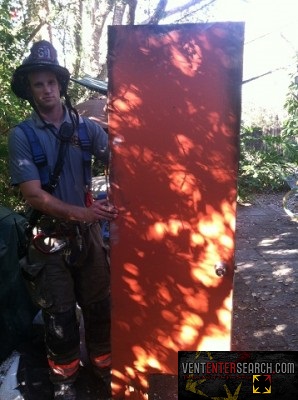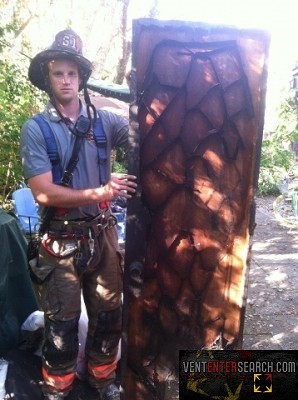After the Governor’s Island project conducted by the National Institute of Standards and Technology (NIST), Underwriters Laboratories(UL), and FDNY, the internet seems to be flooded with great information on flow paths and the importance of confining fire. Most importantly, confining fire is “buying†possible victims’ time from heat and toxic smoke, as well as reducing rapid fire spread. It is extremely important for the interior search teams to find the fire quickly and if possible, confine it. Even if no door is present, i.e. kitchens, find any interior door that can be forced off its hinges and place in the open doorway.
Closing the door while performing vent enter search (VES) operations is a key task. This confines the room being searched from fire and smoke, increasing the survivability of that room. That same tactic needs to be implemented for the fire room, locate and confine so we slow the spread of fire and smoke.
As you can see in the photos, even hollow core wooden doors will hold back fire.
These photos were taken after a recent fire in a single family residence. This door separated the fire room and kitchen, which then led to the remainder of the house. The door was closed before fire was able to spread into the kitchen, saving the home from further fire and smoke damage. The door also provided interior search crews with lighter smoke conditions while searching the uninvolved portion of the home.
Locating and confining fire will save lives and property!



Underwriter’s “Lavatory”, HAHAHA!
Seriously, though, nice pics. It’s funny how something flimsy like a hollow core door will provide a decent barrier. Door control has long been taught for VES, using the can, etc. and these pics help demonstrate its effectiveness.
First time commenting on VES site, although I’ve been following for many years; Great idea using another door to control the flow path!
I was privileged to be a part of “kill the flashover project†a few weeks ago in Columbia South Carolina at the State Fire Academy.
Live burns were conducted using today’s contents. Much like NIST we had thermal image cameras, video, and temperature readings at the ceiling, floor and in between.
Experts from Germany and Sweden were using a fire curtain (easily deployed), with GREAT results. I would not have believed it if I had not seen it firsthand.
Keep up the good work, sharing your expertise!
Just to blow my own horn…I’ve taught about 7 days of classes in the last few weeks and I wish I had a dollar for every time I talked about getting the door closed quickly. This is all.
good for you, you must feel special
That’s what your mom said.
Just a quick comment about the fire curtains used at kill the flashover. I was on the fire attack crew that placed the curtains. Did they ISOLATE the fire? YES. But they also took away the airflow at the bottom of the entrance door. While it’s important to control the door to reduce the air flow to the fire. I think it’s important to know that taking way that flow away at the front door drops the smoke to the floor, reducing the visibility and lessening the chance of survival for victims because of the poor smoke conditions. As stated isolating close to the fire is a great tactic. Near the fire door control stops fire spread, reduces temps, and allows the opportunity to search the rest of the structure. We need to reevaluate advocating strict door control at the front door or at a distance from the fire because of the smoke conditions that it creates between the curtain/door and the fire. Just my 2 cents.